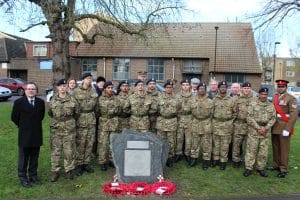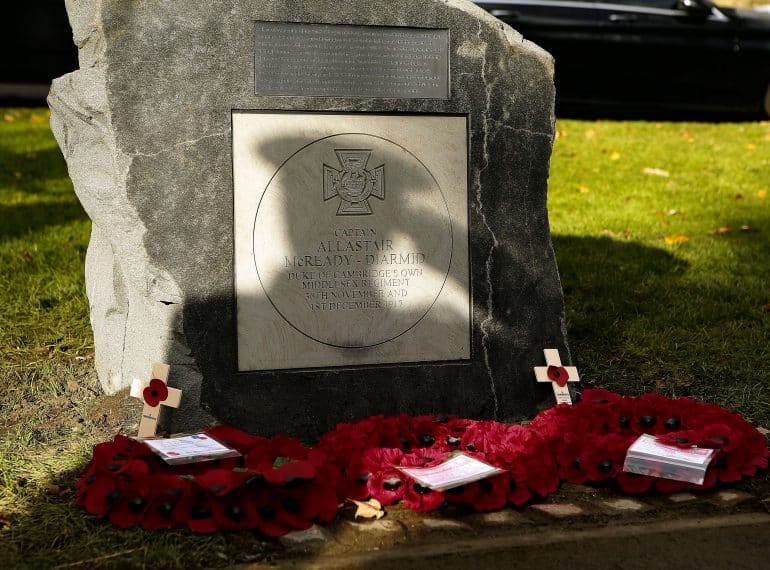Captain Allastair McReady-Diarmid’s attempts to regain enemy territory near Cambrai in France were successful, but he was killed in the action and was awarded the VC – the highest award in the UK’s honours system – posthumously.
The paving stone close to his birthplace in Grove Road, New Southgate is one of a series being laid around the country and unveiled on the centenaries of the deaths of VC recipients.
Among QE representatives attending the ceremony organised by Enfield Council were: Headmaster Neil Enright; one of his predecessors, Eamonn Harris (1984–1999); Head of History Helen MacGregor; the Combined Cadet Force with three CCF staff members (Mev Armon, Charlie-Maud Munro and Richard Scally), and Old Elizabethans Martyn Bradish (1962–1969), Ken Cooper (1942–1950) and Alan Solomon (1951–1957).
 Military representatives included Johnson Beharry, who was awarded the VC for saving members of his unit in Iraq in 2004. He joined QE’s CCF on parade. Lieutenant Colonel D W Utting read out the VC citation.
Military representatives included Johnson Beharry, who was awarded the VC for saving members of his unit in Iraq in 2004. He joined QE’s CCF on parade. Lieutenant Colonel D W Utting read out the VC citation.
Guests were welcomed to the ceremony by Councillor Doug Taylor, the Leader of Enfield Council. Also present was Ann Cable, Deputy Lieutenant for Enfield. The unveiling of the stone was carried out by the Mayor of Enfield, Councillor Christine Hamilton, and by a member of Captain McReady-Diarmid’s family. It was followed by prayers and by a bugler sounding the Last Post and Reveille.
Born Arthur Malcolm Drew in 1888 in Grove Road, New Southgate, Captain McReady-Diarmid was the son of Leslie McReady-Drew and Fannie. The family later lived in Barnet and he attended Queen Elizabeth’s School. He then lived in his mother’s native Jersey for a short period, before moving with the family to Acton, West London, in 1905.
He joined the army at the start of the First World War in 1914 and a year later married 27-year-old Hilda, the couple setting up home in Dursley, Gloucestershire. He changed his name by deed poll to Allastair Malcolm Cluny McReady-Diarmid, apparently because there were so many other Drews in the Middlesex Regiment.

The Account of the Deed – an official summary of the events which led to his being awarded the Victoria Cross – records: “On the 30th November/1st December 1917 at the Moeuvres Sector, France, when the enemy penetrated into our position, and the situation was extremely critical, Captain McReady-Diarmid led his company through a heavy barrage and immediately engaged the enemy and drove them back at least 300 yards, causing numerous casualties and taking 27 prisoners. The following day the enemy again attacked and drove back another company which had lost all its officers. The captain called for volunteers, and leading the attack, again drove them back. It was entirely due to his marvellous throwing of bombs that the ground was regained, but he was eventually killed by a bomb.” His remains were never found.
The VC is given to members of the British armed forces for gallantry in the face of the enemy. The medal bears the simple inscription, ‘For Valour’.
Captain McReady-Diarmid’s VC was presented to his widow at Buckingham Palace in 1918 by George V. In 1927, his daughter, Alison, wore it when the Prince of Wales opened the White Rock Pavilion in Hastings and spoke to the prince of her pride in her father. He was also honoured during this year’s Act of Remembrance at the School in November.
His medal is displayed at the National Army Museum in Chelsea, while Captain McReady-Diarmid’s name is listed on memorials in Cambrai, in Dursley and on Jersey.


